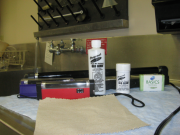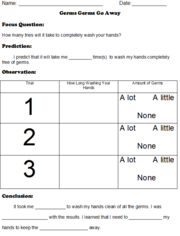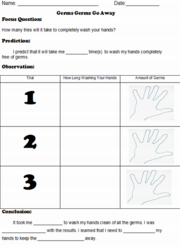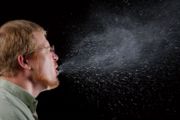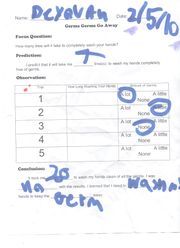Germs germs go away
| Instant wiki maker | Making handouts | Editing tips |
Contents
Biology In Elementary Schools is a Saint Michael's College student project from a course that ran between 2007 and 2010 and fully described in this book chapter. The student-created resources have been preserved here for posterity. Link under 'toolbox' for printer-friendly versions of the exercises. Click on handouts to print full resolution versions. Please see Wikieducator's disclaimer, our safety statement, and the Creative Commons licensing in English and in legalese.
Student worthiness
Tried at least once and worked well.
Primary biological content area covered
- Will encourage students to wash their hands
- Will educate students on how germs are spread
Materials
For Teacher Use
- 3 Black lights (one for each teacher)
- The Magic School Bus: Inside Ralphie by Joanna Cole & Bruce Degen
- Black paper to place on table (better for contrast between powder and black light)
Distributed to Each Student by Teacher
- 8 ounces (one bottle) of Glo Germ Gel (good for about 75 to 100 students)
- 4 ounces (one bottle) of Glo Germ Powder
For Student Use
- Sink with Running Water
- Hand Soap
- Roll of Paper Towels
Handouts
This is a very basic handout that can easily be adapted for any grade level. There is room with this worksheet to either introduce the scientific method or continue practice with it. Have students fill in all the appropriate blanks as they complete the lab. For this specific worksheet, a teacher or the student can time how long it takes for the student to wash their hands. For the third column of the chart have students circle how many germs they believe are still on their hands.
Description of activity
Is it cold and flu season? Do you think your students aren't doing a good job washing their hands? Do you want to teach a quick, easy, and fun lesson on the immune system? This lesson helps with all of these needs. "Germs, Germs, Go Away!" is a great lesson to teach students the correct way to wash their hands--an important thing in any classroom.
<kaltura-widget kalturaid='0_78vdymlx' size='L' align='R'/>
Lesson plan
Before Class
- Gather Materials
- Set up 3 stations:
- Station 1: At this station a teacher/volunteer will distribute gel
- Station 2: At this station students will receive their preliminary view of the germs with a black light
- Station 3: At this station students will receive views of their hands with black light until they are clean
During Class
- Ask and discuss with students if they know how people get colds and the flu
- Ask and discuss with students if they know how the body reacts to germs entering the body
- Ask and discuss with students if they know how to prevent germs from being spread
- Have kids roll up sleeves and stick their hands out
- Form a line that will go through the different stations
- At station 1, squirt about a dime's worth of the GloGerm Gel on each students hand and have them rub it in
- Have students continue to station two and view their hands under the black light for the first time. Have them record their observations.
- Have students wash their hands. Ask students to count how long they are washing their hands for in seconds. Have them record their observations.
- Have students go to station three and view their hands under the black light again. Have them record their observations. If there are germs left repeat steps 9 and 10 until their hands are clean of germs.
- Discuss with students the preliminary questions to see what they have learned. Also, ask students what hand washing methods worked and other ways to prevent germs from spreading
If Time is Available
- Separate the students into groups among the three teachers/volunteers
- Have each teacher/volunteer put a pinch of the powder on their hand.
- Have the teacher/volunteer blow the powder straight forward, creating a sneeze effect.
- Using the black light show students how far germs can go when sneezing
- Discuss with students the proper ways to cover sneezes/coughs
- Read students selected pages from The Magic School Bus: Inside Ralphie by Joanna Cole & Bruce Degen and discuss what germs are, how they are bad, what happens when they enter the body, and why it is important to keep germs away (whichever works best for your grade level)
- Have teacher, unbeknownst to the students, put gel into hand and high five a student or touch different objects.
- Go on a germ hunt with the black light and students. Have them see where the germs go when random objects in the classroom are touched.
Potential pitfalls
We found while doing the experiment, that squirting too much of the lotion was not as effective as a little squirt. With the little squirt, the students were able to rub the lotion completely in. This was good because instead of having their hands completely glowing, they saw the lotion show up in traces over their hands, which made it look more realistic, therefore making it look even more like germs.
With the powder for the "sneeze" demonstration, one should be careful because with too much powder, it will go everywhere. With too little powder, it was not effective. We suggest a nickel-sized portion, but practice it for yourself to ensure that you achieve your desired effect. A good idea is to blow it over black paper so that the "sneezed germs" will really pop when the black light is shined. Also, make sure that you when doing the sneezing experiment that you do it a good distance away from the students. If you do it too close to the students, then they will feel compelled to touch the powder (and once one student touches the powder, they all want to touch the powder).
It is also important to make sure that the students are constantly moving (that the lines are flowing). When the students are standing still, either waiting to use the sink or waiting to see their hands, problems could occur (with spreading the "germs" by touching, for example). This means that you also need to manage your time appropriately so they do not become bored with the activity.
Content Connections
Other Vermont Standards Being Covered HEALTH
HE1: Self Management - Students will understand how to reduce their health risks through the practice of healthy behaviors.
- Demonstrate the skills to promote health
and reduce the spread of germs (e.g., proper hand washing, proper tooth brushing techniques)
HE2: Core Concepts - Students will show an understanding of health promotion and disease prevention concepts.
- Identify basic personal hygiene habits
required to maintain health (e.g., caring for teeth, gums, eyes, ears, nails).
- Recognize the signs and symptoms of
common illnesses (e.g., fever, rashes, coughs, congestion, wheezing).
Information found here:
[1]
Literature connections
Cole, J. and Degen, B. 1995 The Magic School Bus: Inside Ralphie New York: Scholastic Inc.
We will use a copy of The Magic School Bus: Inside Ralphie because that is ideal for children between the ages of 4 and 8. It is a picture book, so it would help children who are visual learners, and better keep the children's attention.
This book explains how germs can enter the body and what happens while they are inside the body, which is something we feel is important to show. In our experiment, students will learn how to keep germs out of their bodies by washing their hands, and the books will show what happens if they still get into the body.
Connections to Science Educational Standards
FROM THE 2nd GRADE VERMONT EDUCATIONAL STANDARDS:
S1-2:42 - Students demonstrate their understanding of the Patterns of Human Health/Disease by…
- Identifying things in the environment that could be harmful if swallowed (e.g., soaps, cleaning solutions, unknown pills).
Science Concepts a. Some things people take into their bodies from the environment are toxic and can hurt them. - We will be completing this standard by discussing how germs can be harmful and stressing the importance of cleanliness.
S1-2:1 - Students demonstrate their understanding of SCIENTIFIC QUESTIONING by…
- Posing observational questions that compare things in terms of number, shape, texture, size, weight, color, motion, etc.(e.g., How fast does a Lady Beetle move compared to a Bess Beetle?).
AND
- Investigating and completing questions to identify a variable that can be changed (e.g., What will happen if…? or I wonder if I change…?).
AND
- Generating new questions that could be explored at the end of an investigation.
Science Concepts -Students will complete this task through their observations recorded on the worksheet and completing the worksheet given to them.
S1-2:2 - Students demonstrate their understanding of PREDICTING AND HYPOTHESIZING by…
- Predicting a logical outcome to a situation, using prior knowledge, experience and/or evidence.
AND
- Explaining reasons for that prediction.
Science Concepts -Students will complete this standard by making their hypothesis and discussing their predictions with other students.
S1-2:5 - Students demonstrate their ability to REPRESENT DATA by…
- Organizing a collection of data into a table or a graph template.
AND
- Creating a title for a table or graph.
Science Concepts -We will be completing this standard through having the students complete the worksheet
FROM THE 3rd GRADE VERMONT EDUCATIONAL STANDARDS:
S3-4:42 - Students demonstrate their understanding of the patterns of Human Health/Disease by…
- Explaining how tears, saliva, and skin, can protect the body from harmful germs.
Science Concepts: a. If germs are able to get inside a person’s body, they may keep it from working properly. Tears, saliva, and skin protect our bodies from germs. - Similarly to the previous standard, we will be using this standard to show how the skin protects from harmful germs, and how one can keep their skin clean and protect themselves.
Information found here: [2]
Next steps
This activity could lead to many others, as it is an introduction to cleanliness, germs and the spread of germs, both which could lead to discussions on germ-related illnesses, proper sanitation, and even the immune system in general. To further with this activity, you could use the gel to spread it in different areas around the classroom which get the most contact. After doing this (make sure that you do this while the students are not there as you do not want them to know exactly where you spread the gel), have the students use the black light to find such areas. This would be a good activity to show the importance of frequently washing your hands and other health subjects of the sort.
Reflections
KM
Personally, I felt that this activity was a huge success. Not only did the students really enjoy doing the activity, but it was also one which engaged and captivated them early on so they were motivated to do it. It was key, when explaining the activity to the students, that we emphasized certain aspects of the activity to them, such as the germs they see are not real germs, as I also found some of the students to be very skeptical at times in completing the activity when they did not know this. Other then that one minor setback, however, I found the entire activity to go very smoothly. It was good to have the students move from one person who put the gel on, to the next person to see the germs, and finally to the last person to wash their hands. It would have been better with one more station to separate from the others to see the product of the first wash, however, that was not a big deal (it just caused a little crowding by the sink and black light at times). I felt that each one of us did a very good job in explaining the activity to the students in a manner in which they could easily understand, and also at keeping the activity flowing. Talking with some of the students, I found that our explanations and discussion about germs before hand allowed them to grasp what needed to be understood within the activity and that a majority of them left with an understanding of the point we were trying to get across. Overall, I feel as though this would be a great activity for the grades that we did the activity with (first and second), as it might be a little too elementary for the older grades (though it could possibly work if other elements are added to it).
HM I was very excited to see how excited the students were for this activity. Hearing the students say things like "Wow, that's so cool!" and calling out to their friends to "Come check this out" was rewarding. From the very beginning they were hooked, eagerly discussing how germs are spread. When we explained the activity, they couldn't wait to run into line to get the lotion and see the "germs," and then see how well they wash their hands. Some of the kids didn't realize that the lotion wasn't showing real germs, and that it was simulating germs. Once they realized it wasn't real germs, some of them weren't quite as excited but it relieved some students' anxieties.
JM This was a very new experience for me. In the past I usually worked solely with upper elementary in the areas of social studies and language arts, but I was pleasantly surprised at the kids' enthusiasm for science. I really enjoyed the hands-on component to our lesson; it made kids want to learn. Some students looked as though they were having so much fun they didn't realize they were actually learning too. Also, we decided to test two different worksheets, which made us learn just as much as the students were. Our lab was not a perfect lab however, often we found the students easily distracted and quite boisterous. This science lesson has a tendency to be too fun, which attributes to both misbehavior and a lack of willingness to do the worksheet provided. I have picked four examples of student work to showcase the variety of work we got handed in. If replicated, I would make a sincere effort in discussing the direction and enforcing the rules better. This lab is definitely not a one person job, if possible i would invite 2 or 3 volunteers in to assist with the transition and activity at stations.
Citations and links
This lab was created from an idea started in a 2008-2009 Child Development II class at Portsmouth High School in RI.
Creese, Dianne, and Child Development Class. Science Labs for Kids. Portsmouth High School, Portsmouth. Spring 2009. Lecture.
Link to purchase gel and materials:
http://www.hometrainingtools.com/glo-germ-gel-8-oz./p/BE-GLOGEL
http://www.hometrainingtools.com/glo-germ-powder-4-oz./p/BE-GLOPOWD
Link for the Vermont Standards Content Connections:
Link for Connections to Science Educational Standards From the 2nd Grade VT Educational Standards:
2. http://education.vermont.gov/new/html/pgm_health_ed/gle.html

